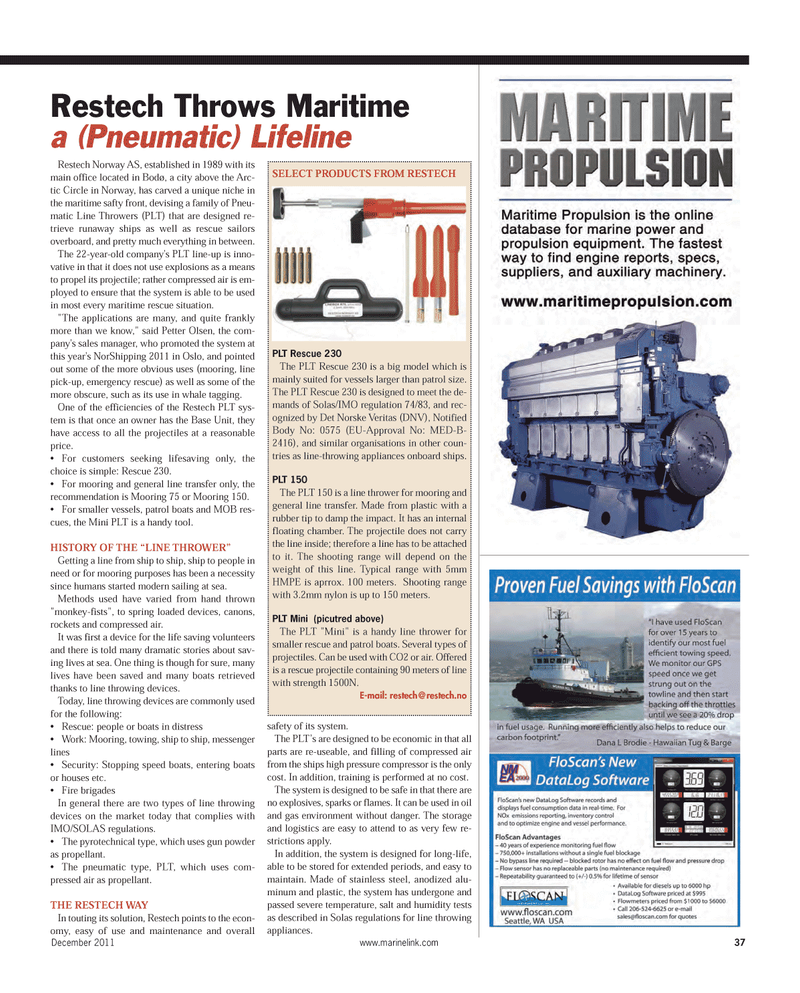
Page 37: of Maritime Reporter Magazine (December 2011)
Great Ships of 2011
Read this page in Pdf, Flash or Html5 edition of December 2011 Maritime Reporter Magazine
Restech Norway AS, established in 1989 with its main office located in Bodø, a city above the Arc- tic Circle in Norway, has carved a unique niche in the maritime safty front, devising a family of Pneu- matic Line Throwers (PLT) that are designed re- trieve runaway ships as well as rescue sailors overboard, and pretty much everything in between. The 22-year-old company's PLT line-up is inno- vative in that it does not use explosions as a means to propel its projectile; rather compressed air is em-ployed to ensure that the system is able to be used in most every maritime rescue situation. "The applications are many, and quite frankly more than we know," said Petter Olsen, the com- pany's sales manager, who promoted the system at this year's NorShipping 2011 in Oslo, and pointedout some of the more obvious uses (mooring, line pick-up, emergency rescue) as well as some of the more obscure, such as its use in whale tagging.One of the efficiencies of the Restech PLT sys- tem is that once an owner has the Base Unit, they have access to all the projectiles at a reasonable price. For customers seeking lifesaving only, the choice is simple: Rescue 230. For mooring and general line transfer only, the recommendation is Mooring 75 or Mooring 150. For smaller vessels, patrol boats and MOB res- cues, the Mini PLT is a handy tool. HISTORY OF THE ?LINE THROWER? Getting a line from ship to ship, ship to people inneed or for mooring purposes has been a necessitysince humans started modern sailing at sea. Methods used have varied from hand thrown "monkey-fists", to spring loaded devices, canons, rockets and compressed air. It was first a device for the life saving volunteers and there is told many dramatic stories about sav- ing lives at sea. One thing is though for sure, many lives have been saved and many boats retrieved thanks to line throwing devices. Today, line throwing devices are commonly used for the following: Rescue: people or boats in distress Work: Mooring, towing, ship to ship, messenger linesSecurity: Stopping speed boats, entering boats or houses etc. Fire brigades In general there are two types of line throwing devices on the market today that complies with IMO/SOLAS regulations. The pyrotechnical type, which uses gun powder as propellant. The pneumatic type, PLT, which uses com- pressed air as propellant. THE RESTECH WAY In touting its solution, Restech points to the econ-omy, easy of use and maintenance and overall safety of its system.The PLT?s are designed to be economic in that all parts are re-useable, and filling of compressed air from the ships high pressure compressor is the onlycost. In addition, training is performed at no cost. The system is designed to be safe in that there areno explosives, sparks or flames. It can be used in oil and gas environment without danger. The storage and logistics are easy to attend to as very few re- strictions apply. In addition, the system is designed for long-life,able to be stored for extended periods, and easy to maintain. Made of stainless steel, anodized alu-minum and plastic, the system has undergone and passed severe temperature, salt and humidity tests as described in Solas regulations for line throwing appliances. December 2011www.marinelink.com 37Restech Throws Maritime a (Pneumatic) LifelineSELECT PRODUCTS FROM RESTECH PLT Rescue 230 The PLT Rescue 230 is a big model which is mainly suited for vessels larger than patrol size. The PLT Rescue 230 is designed to meet the de- mands of Solas/IMO regulation 74/83, and rec- ognized by Det Norske Veritas (DNV), Notified Body No: 0575 (EU-Approval No: MED-B- 2416), and similar organisations in other coun- tries as line-throwing appliances onboard ships. PLT 150 The PLT 150 is a line thrower for mooring and general line transfer. Made from plastic with a rubber tip to damp the impact. It has an internalfloating chamber. The projectile does not carry the line inside; therefore a line has to be attachedto it. The shooting range will depend on the weight of this line. Typical range with 5mm HMPE is aprrox. 100 meters. Shooting rangewith 3.2mm nylon is up to 150 meters. PLT Mini (picutred above) The PLT "Mini" is a handy line thrower for smaller rescue and patrol boats. Several types of projectiles. Can be used with CO2 or air. Offered is a rescue projectile containing 90 meters of linewith strength 1500N. E-mail: [email protected] Dec.11 # 5 (34-41):MR Template 12/6/2011 3:50 PM Page 37

 36
36

 38
38
